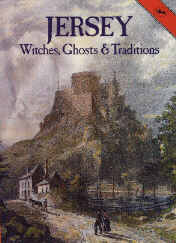Sonia Hillsdon
Jersey Witches, Ghosts and Traditions

All about the Islanders' war with the Devil and the consequent trial of Jersey witches, plus traditional tales from the 12 Parishes.
From the book:
Witches
The outsider, the one who dares to be different, has always been mistrusted. When crops fail or children die unexpectedly, the blame has to be laid at somebody's door. But it must be admitted, too, that being the member of a secret, anti-establishment society has always held a great attraction for some young and old - men and women.
The power that a witch is supposed to have - be he eccentric, scapegoat or member of a secret cult, is called 'magic'. As Freud observes: 'Magic has to serve the most varied purposes it must subject natural phenomena to the will of man, it must protect the individual from his enemies and from dangers and it must give him power to injure his enemies.' Freud concludes, therefore, that 'it is easy to perceive the motives which lead men to practise magic: they are human wishes.'
When it comes to Jersey witches, G. R. Balleine whose work on the subject in the 1930s is invaluable is in no doubt as to which category they belong, 'In the sixteenth and seventeenth centuries all the Governments of Western Europe, Catholic and Protestant alike, were fighting a fanatical secret society.' This secret society had the Devil as its god and parodies of Christian Sacraments as its rituals. Balleine also believed that it was a cult organised on international lines. Its travelling ministry gave the same instructions to every coven, whatever their country whether it practised in Pendle Forest, in Brittany, in the Orkneys, Sweden or here, in Jersey. For witch trials all over Europe have revealed that the organisation was always the same. When Mussorgsky wrote his 'St John's Night on the Bare Mountain' in 1867, he was describing in musical terms the almost identical rites that used to be practised by witches in his native Russia.
Each coven, or committee running the local branch of the society, had to have thirteen members. The President of the Sabbat, or meeting, which was usually held on a Friday, was always a man - previously unknown in the locality. He was believed to be the Devil himself and, to lead the rituals, dressed himself in skins and covered his head with a mask, usually of a horned animal such as a bull, goat or stag. Homage was paid to him by kissing his backside. All new converts he stamped or tattooed with an indelible secret mark 'la merche du diable'.
How did such a secret society come into being? Why did it grow to such proportions in the Europe of the sixteenth and seventeenth centuries in particular? There are two theories. One is that the pagan rites, which the Catholic Church tried so hard to eradicate, were never quite wiped out, They merely went underground but, ironically, because of Catholic influence, the old pagan gods were now worshipped as devils. Another theory is that Devil worship was one of the many heresies that flourished in the Middle Ages. Whatever the origin of Devil worship and its attendant witchcraft, it obviously took advantage of the schisms in the established Catholic Church and came to the height of its power at the time of the Reformation and its aftermath.
In Jersey, though there were witch trials right through the reigns of Elizabeth I, James I, Charles I and during the Civil War, they began to be held in ever-increasing numbers while the Island was in the grip of Calvinism, The years from 1548 to 1620 were a time of theocracy, when Church and State combined to keep the community in God's favour, They attempted this by austere discipline, hard work, much prayer and abstinence from what they considered 'lewd' amusements.
Anyone who deviated from Calvin's strict code of conduct was considered to be in the pay of the Devil and, therefore, a threat to God himself. For the sake of the Island's good government and the spiritual well-being of its population, all such deviants such as witches had to be hunted out and destroyed.
There is no doubt, therefore, that both civil and ecclesiastical authorities, as well as the common people of Jersey, believed most definitely in witches and their power to subvert. It was a strong and long-lasting belief that manifested itself in superstitions as well as inhumane ways of stamping out the evil.
Jarrolds £4.95
Order from the Société Jersiaise
Back to home page

















